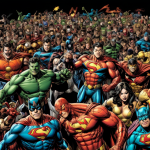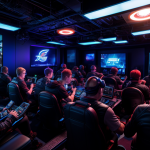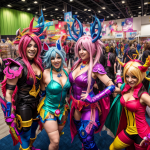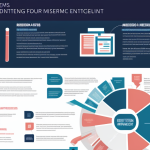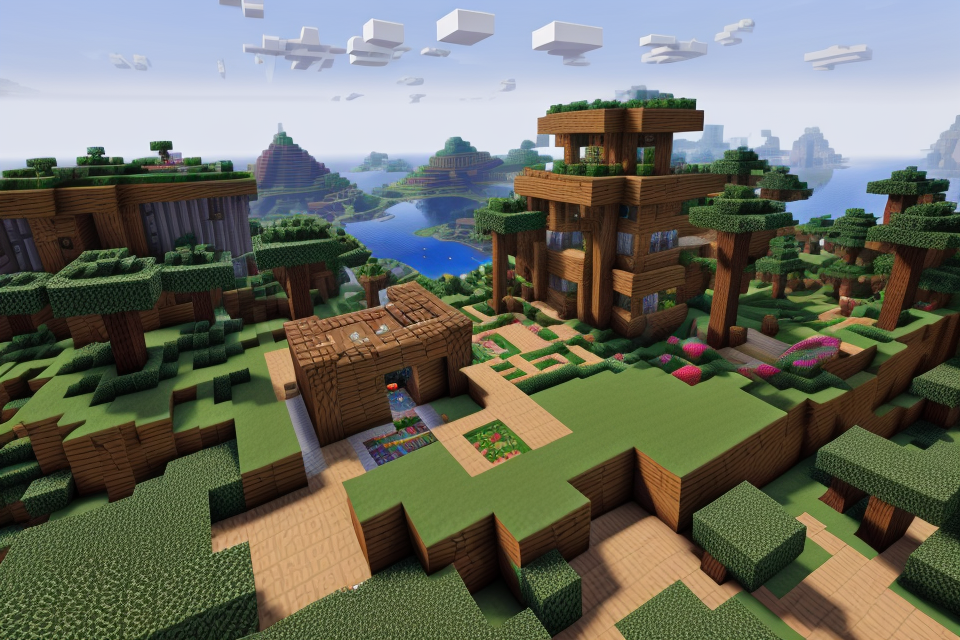The gaming industry has come a long way since its inception, with games becoming increasingly sophisticated and popular among players of all ages. However, there is one game that stands out above the rest as the most popular video game of all time. This game has taken the world by storm, becoming a cultural phenomenon and a staple in the gaming industry. It’s a game that has transcended beyond the realm of just being a game, and has left an indelible mark on popular culture. The game in question is none other than Minecraft.
Minecraft, created by Mojang Studios, was first released in 2011 and has since become a global sensation. With its unique blend of creativity, exploration, and survival gameplay, Minecraft has captured the hearts of millions of players worldwide. The game’s pixelated graphics and blocky aesthetic may be simple, but its gameplay is anything but. Players can build massive structures, explore vast landscapes, and battle fearsome enemies, all while mining for resources and crafting new tools and weapons.
The influence of Minecraft on popular culture and the gaming industry cannot be overstated. The game has inspired countless fan-made creations, from cosplay to fan art, and has even spawned a popular movie franchise. Minecraft has also influenced other games, with many developers incorporating similar gameplay mechanics and aesthetics into their own games. The game’s impact on the gaming industry has been so significant that it has become a benchmark for other games to measure up to.
In conclusion, Minecraft is not just a game, but a cultural phenomenon that has captured the hearts and minds of millions of players worldwide. Its influence on popular culture and the gaming industry cannot be denied, and it will continue to be a staple in the gaming world for years to come.
The Rise of “Minecraft” as a Cultural Phenomenon
The Game’s Humble Beginnings
The humble beginnings of Minecraft can be traced back to 2009 when it was first created by Swedish game developer, Markus “Notch” Persson. At the time, Minecraft was simply a small indie game with a focus on creativity and exploration. However, it quickly gained popularity among a niche audience of gamers who appreciated its unique sandbox-style gameplay.
One of the key factors that contributed to Minecraft’s initial success was its focus on user-generated content. Players were encouraged to create their own worlds, build structures, and share them with others. This sense of community and collaboration helped to drive the game’s popularity, as players were constantly sharing their creations and showcasing their skills.
Another factor that contributed to Minecraft’s rise was its unique visual style. The game’s blocky, pixelated graphics may have been simple, but they were also charming and distinctive. This visual style helped to set Minecraft apart from other games at the time, and it quickly became one of the most recognizable game aesthetics in the industry.
Despite its humble beginnings, Minecraft’s popularity continued to grow over the years. It was eventually acquired by Microsoft in 2014, and it has since become one of the best-selling video games of all time, with over 200 million copies sold worldwide. Today, Minecraft is a cultural phenomenon that has inspired countless fan-made creations, merchandise, and even a hit movie. Its impact on popular culture and the gaming industry cannot be overstated, and its influence can be seen in countless other games and media products.
The Game’s Surprising Success
Since its initial release in 2011, Minecraft has experienced a meteoric rise to become one of the most popular and influential video games of all time. This unexpected success can be attributed to several factors, including its unique gameplay mechanics, extensive customization options, and the creation of a thriving online community.
One of the primary reasons for Minecraft’s surprising success is its innovative gameplay mechanics. The game’s sandbox-style approach, which allows players to explore and build within a blocky 3D world, offers a level of creative freedom rarely seen in other video games. Players can gather resources, craft tools and weapons, and construct elaborate structures, all while navigating treacherous terrain and fending off dangerous creatures. This blend of exploration, survival, and creativity has proven to be a winning combination, captivating audiences of all ages and backgrounds.
Another factor contributing to Minecraft’s success is the game’s extensive customization options. Players can personalize their experience by selecting from a vast array of skins, textures, and resource packs, allowing them to tailor the game’s aesthetics to their preferences. Additionally, the game’s built-in editing tools and modding support have enabled a thriving community of content creators, who have developed custom maps, textures, and gameplay modifications that further enhance the overall experience. This level of player agency and control has been instrumental in Minecraft’s continued popularity, as it allows players to shape the game world to their liking and fosters a sense of ownership and investment in the game.
Lastly, the creation of a vibrant online community has played a crucial role in Minecraft’s surprising success. The game’s multiplayer functionality has facilitated the formation of numerous online communities, including dedicated servers, clans, and social media groups. These communities have fostered a sense of camaraderie and collaboration among players, as they work together to build elaborate structures, complete challenging tasks, and share their creations with others. This sense of shared experience and social interaction has helped to sustain Minecraft’s popularity, as players continue to connect and engage with one another through the game’s online platforms.
In summary, Minecraft’s surprising success can be attributed to its innovative gameplay mechanics, extensive customization options, and the creation of a thriving online community. These factors have combined to make Minecraft one of the most popular and influential video games of all time, shaping the course of the gaming industry and leaving an indelible mark on popular culture.
The Impact of “Minecraft” on the Gaming Industry
Changing the Landscape of Gaming
- Introduction
- The emergence of “Minecraft” as a game-changer in the gaming industry
- Its impact on popular culture and the way games are perceived
- Sandbox Gaming
- The concept of sandbox gaming and its significance in the gaming industry
- How “Minecraft” popularized the genre and inspired new games
- Creativity and Player-driven Content
- The emphasis on creativity and player-driven content in “Minecraft”
- How this has influenced other games to incorporate similar features
- Cross-Platform Playability
- The introduction of cross-platform playability in “Minecraft”
- How this has changed the way games are marketed and played
- Modding Community
- The role of the modding community in the success of “Minecraft”
- How this has led to a rise in player-created content and modding in other games
- Conclusion
- The lasting impact of “Minecraft” on the gaming industry
- Its influence on future games and the direction of the industry
The Game’s Influence on Future Titles
Innovative Gameplay Mechanics
- Sandbox-style gameplay
- Open-ended exploration
- Crafting system
- Survival and creative modes
Virtual World Design
- Procedurally generated environments
- Dynamic weather and lighting
- Terrain manipulation
- Dynamic biomes
Multiplayer Experience
- Seamless multiplayer
- Server-based gameplay
- User-generated content
- Co-operative and competitive game modes
Accessibility and Cross-Platform Play
- Availability on multiple platforms
- Support for controllers and keyboard/mouse
- Seamless cross-platform play
- Accessible for players with disabilities
Creative and Educational Applications
- Educational tools and resources
- Encouraging creativity and problem-solving
- Digital storytelling and world-building
- Used in classrooms and educational settings
These innovations have influenced the development of future titles, with many games incorporating similar mechanics, virtual world design, multiplayer experiences, and accessibility features. “Minecraft” has paved the way for new generations of games that encourage creativity, exploration, and community-driven content.
The Phenomenon of “Minecraft” Streaming and YouTube Content
The Role of Streamers in Popularizing the Game
Since its release in 2011, “Minecraft” has become a cultural phenomenon, and its success can be largely attributed to the role of streamers on platforms like YouTube and Twitch. These online personalities have played a crucial role in popularizing the game, reaching millions of viewers worldwide and turning it into a mainstream sensation.
- Early Adopcrators and Influencers
Streamers were among the early adopcrators of “Minecraft,” and their enthusiasm for the game helped to generate interest and excitement among their audiences. As they shared their experiences and showcased the game’s unique features, viewers were drawn in and eager to try it out for themselves. - Creative Content and Sharing
Streamers played a significant role in expanding the game’s content and fostering a sense of community. They shared their creative builds, survival tips, and exploration adventures, encouraging others to join in and contribute their own creations. This collaborative approach helped to build a vibrant and engaged audience, as players felt inspired to participate and share their own experiences. - Entertainment and Education
Streamers not only provided entertainment but also served as a source of education for many players. They offered tutorials, explained game mechanics, and shared strategies for survival and construction. By demonstrating the game’s potential and providing helpful guidance, streamers made “Minecraft” accessible to a wider audience and encouraged players to experiment and push the boundaries of what was possible in the game. - Brand Ambassadors and Monetization
As the game’s popularity grew, streamers became brand ambassadors for “Minecraft,” helping to promote it to a wider audience. Many streamers monetized their content through advertisements, sponsorships, and merchandise sales, providing them with a financial incentive to continue creating and sharing content. This mutually beneficial relationship between streamers and “Minecraft” further fueled the game’s success and helped to establish it as a cultural phenomenon.
In summary, the role of streamers in popularizing “Minecraft” cannot be overstated. By showcasing the game’s potential, fostering a sense of community, and providing entertainment and education, they played a crucial role in its rise to fame. Their influence continues to shape the gaming industry and popular culture at large, as “Minecraft” remains a beloved and influential game for millions of players worldwide.
The Success of “Minecraft” Content Creators on YouTube
The Emergence of Minecraft Streamers
The popularity of “Minecraft” on YouTube has led to the emergence of a new breed of content creators known as Minecraft streamers. These streamers are individuals who play the game live on YouTube while interacting with their audience through chat and live commentary. The emergence of Minecraft streamers has been attributed to the game’s highly engaging and interactive nature, which allows for endless possibilities for creative content.
The Rise of Minecraft Streaming Channels
As Minecraft streaming gained popularity, many YouTube channels dedicated solely to Minecraft content began to emerge. These channels typically feature live streams of players exploring the game’s vast virtual worlds, building structures, and engaging in battles with various creatures. Some of the most popular Minecraft streamers have amassed millions of subscribers, with some even earning a full-time income from their streams.
The Impact of Minecraft Streamers on YouTube
The success of Minecraft streamers on YouTube has had a significant impact on the platform. Minecraft content has become one of the most viewed and subscribed-to genres on YouTube, with many streamers gaining massive followings and earning significant revenue from their content. The popularity of Minecraft streaming has also led to the creation of entire communities around the game, with fans eagerly following their favorite streamers and engaging with their content.
The Evolution of Minecraft Streaming
Over time, Minecraft streaming has evolved from simple live streams of players playing the game to more complex productions that incorporate editing, special effects, and even live events. Many Minecraft streamers have also branched out into other areas of content creation, such as creating custom mods and resource packs for the game, or even developing their own games.
In conclusion, the success of Minecraft content creators on YouTube has been a major factor in the game’s popularity and influence on popular culture. The emergence of Minecraft streaming channels, the impact on YouTube, and the evolution of Minecraft streaming demonstrate the power of the game to captivate audiences and inspire creativity.
The Cultural Significance of “Minecraft”
The Game’s Influence on Art and Design
The game’s blocky, pixelated aesthetic has had a significant impact on the art and design world. Many artists have been inspired by the game’s unique style, incorporating it into their own works. The game’s use of color and texture has influenced the design of everything from clothing to furniture.
In addition to its visual impact, “Minecraft” has also had an impact on the gaming industry as a whole. Its sandbox-style gameplay and focus on creativity and exploration has inspired a new generation of games that emphasize player choice and freedom. This has led to the development of games that blur the lines between genres, allowing players to experience a wide range of gameplay styles in a single game.
The game’s popularity has also led to the development of a thriving modding community, where players can create and share their own custom content for the game. This has led to the creation of new game modes, resources, and even entire games within the “Minecraft” universe.
Furthermore, the game’s emphasis on player-generated content has inspired other games to incorporate similar features, allowing players to create and share their own content within the game. This has led to the development of a new type of game, often referred to as “sandbox” games, which focus on player creativity and exploration.
In conclusion, “Minecraft” has had a profound impact on the art and design world, as well as the gaming industry as a whole. Its unique style and gameplay have inspired a new generation of games that emphasize player choice and freedom, while its focus on player-generated content has led to the development of a thriving modding community.
The Game’s Impact on Education and Learning
- Revolutionizing Education:
- The game has been used as an educational tool in classrooms, allowing students to learn about subjects such as science, history, and math in a more interactive and engaging way.
- By creating a virtual world for students to explore, the game promotes critical thinking, problem-solving, and teamwork skills.
- The game has been used to teach coding and computer science, providing students with a hands-on approach to learning programming concepts.
- Accessibility and Inclusivity:
- The game is accessible to players of all ages and abilities, making it a valuable tool for special education and inclusive classrooms.
- The game’s open-ended nature allows for customization and modification, making it possible for players to tailor the experience to their individual needs and interests.
- The game’s multiplayer mode promotes social interaction and collaboration, helping to build community and inclusion in the classroom.
- Gamification of Education:
- The game has been used to teach a variety of subjects, including literacy, language arts, and social studies.
- By incorporating the game into the curriculum, teachers are able to make learning more fun and engaging for students, increasing motivation and retention of information.
- The game has been used to promote environmental education, allowing students to learn about conservation and sustainability in a hands-on way.
- Creating Future Innovators:
- The game has been shown to promote creativity and innovation in young players, inspiring them to think outside the box and develop problem-solving skills.
- By providing a platform for experimentation and exploration, the game encourages players to take risks and think creatively, fostering a mindset of innovation and entrepreneurship.
- The game has been used to teach entrepreneurship and business skills, providing students with a real-world application of the skills they learn in the game.
The Controversies Surrounding “Minecraft”
Concerns Over Violence and Graphic Content
Despite its massive popularity, “Minecraft” has faced numerous controversies since its release in 2011. One of the primary concerns has been the game’s violence and graphic content, which some argue is inappropriate for children. Critics argue that the game’s survival mode, where players must fend off hostile creatures and explore dangerous environments, promotes a culture of violence. Additionally, the game’s blocky graphics and character design have been criticized for being too reminiscent of earlier games such as “Doom” and “Quake,” which were known for their intense violence and gore.
Critics also point out that the game’s open-ended nature can lead to players engaging in harmful or offensive behavior, such as building structures or creating scenarios that promote racism, sexism, or other forms of discrimination. Some have even suggested that the game’s popularity has contributed to a rise in violent behavior among young people.
In response to these concerns, developers have made efforts to tone down the game’s violence and add more educational and creative elements. However, the game’s continued popularity and the widespread availability of mods and user-generated content mean that the issue remains a contentious one.
It is worth noting that many parents and educators have defended the game, arguing that it promotes creativity, problem-solving, and collaboration. They point out that the game’s survival mode can be turned off, and that the game offers a wide range of non-violent gameplay options, such as building structures, exploring, and engaging in peaceful activities like farming and fishing. Additionally, many argue that the game’s educational value cannot be overstated, as it teaches players important skills such as resource management, planning, and spatial reasoning.
Despite these defenses, the issue of violence and graphic content in “Minecraft” remains a subject of debate and controversy. While some see the game as a harmless and even beneficial form of entertainment, others view it as a potentially harmful influence on young people and a perpetuator of violent and offensive content.
Debates Over the Educational Value of the Game
The debate over the educational value of “Minecraft” has been a contentious issue since the game’s release. While some argue that the game promotes creativity, problem-solving, and collaboration, others contend that it is a mindless distraction that hinders learning.
The Positive Effects of “Minecraft” on Education
Proponents of “Minecraft” in education argue that the game promotes several important skills, including:
- Creativity: Players are encouraged to build and design their own worlds, fostering creativity and imagination.
- Problem-solving: The game requires players to navigate complex challenges and obstacles, promoting critical thinking and problem-solving abilities.
- Collaboration: “Minecraft” can be played in multiplayer mode, allowing players to work together and collaborate on building projects, teaching them the importance of teamwork and communication.
The Negative Effects of “Minecraft” on Education
Critics of “Minecraft” in education argue that the game is a distraction that takes away from important learning opportunities. They claim that the game can be addictive and may lead to decreased academic performance. Some have also raised concerns about the potential for violent or inappropriate content in the game, which could negatively impact the learning environment.
The Debate Continues
Despite the ongoing debate, many educators have embraced “Minecraft” as a valuable tool for teaching a variety of subjects, including science, math, and history. The game has been used in classrooms across the globe, with some schools even offering “Minecraft” as part of their curriculum. However, other schools have banned the game due to concerns about its potential negative effects on learning.
The debate over the educational value of “Minecraft” highlights the complex relationship between video games and education. While some see the game as a valuable teaching tool, others remain skeptical of its impact on learning. As the game continues to evolve and be integrated into classrooms around the world, it remains to be seen how its impact on education will ultimately be perceived.
The Future of “Minecraft” and Its Legacy
The Game’s Continued Popularity and Evolution
Since its release in 2011, “Minecraft” has become a cultural phenomenon and a staple in the gaming industry. Its popularity has transcended borders and has attracted a wide range of players, from children to adults. The game’s continued popularity can be attributed to its unique gameplay, creative mode, and multiplayer feature.
Unique Gameplay
“Minecraft” has a unique gameplay that sets it apart from other games. The game allows players to build structures, gather resources, and battle monsters in a blocky 3D world. The game’s sandbox-style gameplay provides players with the freedom to explore and create their own world, which has made it popular among players who enjoy open-ended gameplay.
Creative Mode
In addition to the survival mode, “Minecraft” also has a creative mode, which allows players to build structures without the threat of monsters or hunger. This mode has made the game accessible to players who may not be interested in the survival aspect of the game, but are still interested in the building and creative aspects.
Multiplayer Feature
The multiplayer feature in “Minecraft” has also contributed to the game’s continued popularity. Players can join together in the same world and build structures, trade resources, and battle monsters together. This feature has made the game social and has encouraged players to work together and share their creations with others.
Furthermore, the game’s continued evolution has ensured that it remains relevant and engaging to players. Regular updates and expansions have added new features, biomes, and creatures to the game, keeping it fresh and exciting for players. The game’s developers, Mojang, have also been responsive to player feedback, ensuring that the game remains balanced and enjoyable for all players.
In conclusion, the continued popularity and evolution of “Minecraft” can be attributed to its unique gameplay, creative mode, and multiplayer feature. The game’s enduring appeal has made it a cultural phenomenon and a staple in the gaming industry, and its future looks bright as it continues to evolve and attract new players.
The Enduring Impact of “Minecraft” on Gaming and Popular Culture
“Minecraft” has left an indelible mark on both the gaming and popular culture industries, with its influence continuing to be felt long after its initial release.
One of the most significant impacts of “Minecraft” has been on the gaming industry itself. The game’s unique blend of open-world exploration, creative building, and survival gameplay has inspired countless other games to follow in its footsteps. Many of these games have sought to emulate “Minecraft’s” blocky aesthetic and sandbox-style gameplay, with some even going so far as to incorporate the game’s signature crafting mechanics and resource gathering.
Furthermore, “Minecraft” has also had a profound impact on the broader cultural landscape. The game’s massive popularity has led to its incorporation into numerous popular media, including films, television shows, and even literature. The game’s distinctive visual style and iconic characters have become recognizable symbols of modern popular culture, with the game’s influence being felt in everything from fashion to music.
Moreover, “Minecraft” has also had a significant impact on the world of education. The game’s focus on creativity, problem-solving, and collaboration has made it a popular tool for teachers looking to engage students in interactive, hands-on learning experiences. Many educators have incorporated “Minecraft” into their lesson plans, using the game to teach subjects ranging from math and science to history and language arts.
Overall, the enduring impact of “Minecraft” on both gaming and popular culture cannot be overstated. The game’s unique blend of creativity, exploration, and survival gameplay has captured the imaginations of millions of players around the world, and its influence can be seen in countless other games, media, and educational contexts. As the game continues to evolve and expand, its legacy is sure to endure for many years to come.
FAQs
1. What is Minecraft?
Minecraft is a popular sandbox video game that was released in 2011. It was created by Markus “Notch” Persson and later developed and published by Mojang. The game allows players to build and explore a blocky 3D world with others.
2. What makes Minecraft popular?
Minecraft’s popularity can be attributed to its unique gameplay and creative freedom. Players can build and explore anything they can imagine, from simple houses to elaborate castles. The game also has a survival mode where players must gather resources and fend off monsters to survive. Additionally, Minecraft has a large and active community that creates and shares custom maps, mods, and skins.
3. How has Minecraft influenced popular culture?
Minecraft has had a significant impact on popular culture. The game’s blocky graphics and pixelated style have become a staple of modern video game design. Minecraft has also inspired numerous memes, videos, and fan art. Additionally, Minecraft has been referenced in numerous TV shows, movies, and music videos.
4. What is the gaming industry?
The gaming industry refers to the business of developing, publishing, and selling video games. It includes a wide range of companies, from small indie studios to large multinational corporations. The industry encompasses a variety of platforms, including consoles, PCs, mobile devices, and virtual reality headsets.
5. How has Minecraft influenced the gaming industry?
Minecraft has had a significant impact on the gaming industry. The game’s success has inspired a wave of similar sandbox games, such as Terraria and Don’t Starve. Additionally, Minecraft has demonstrated the potential for indie games to become massive hits, inspiring a new generation of developers to create their own unique games.
6. Who created Minecraft?
Minecraft was created by Markus “Notch” Persson, a Swedish game developer. Notch initially created the game as a solo project, but later formed Mojang to publish and develop the game.
7. When was Minecraft released?
Minecraft was first released in 2011 for PC. It has since been released on numerous platforms, including consoles, mobile devices, and virtual reality headsets.
8. What are some popular Minecraft mods?
Some popular Minecraft mods include those that add new biomes, creatures, and items to the game. Other mods add new gameplay mechanics, such as the ability to fly or brew potions. Some mods also change the game’s graphics or add new textures.
9. How does Minecraft compare to other popular video games?
Minecraft’s unique gameplay and creative freedom set it apart from other popular video games. While many games focus on action and competition, Minecraft encourages players to explore and build at their own pace. The game’s blocky graphics and pixelated style have also become a defining feature of modern video game design.
10. What is the future of Minecraft?
Minecraft’s future is likely to include new updates and content for existing players, as well as new platforms and versions of the game. Mojang has announced plans to release a new version of the game called Minecraft: The Adventure Game, which will focus on storytelling and exploration. Additionally, Minecraft’s popularity is likely to continue to inspire new games and creative projects in the years to come.
